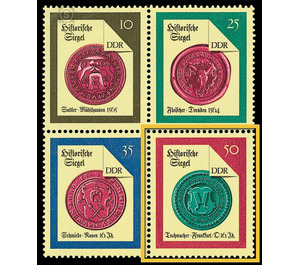Commemorative stamp series - Germany / German Democratic Republic 1988 - 50 Pfennig
Theme: Post & Philately
| Country | Germany / German Democratic Republic |
| Issue Date | 1988 |
| Face Value | 50.00 |
| Color | red |
| Perforation | K 14 |
| Printing Type | Rotogravure 2 |
| Stamp Type | Postage stamp |
| Item Type | Stamp |
| Chronological Issue Number | 2901 |
| Chronological Chapter | GER-DDR |
| SID | 611758 |
| In 17 Wishlists | |
Historical seals With the illustrations of historical seals, the Ministry of Posts and Telecommunications of the German Democratic Republic issues four multi-colored special postage stamps, one after the other and in a printed version. Special cancellations from March 22 to May 21, 1988 Historical seal The seal of the blossoming of the guilds in the period of high feudalism (15th GDR issue of 1984) is followed by craft seals from the second half of the 16th century, a time of great importance for the middle classes of the bourgeoisie after the defeat of the early bourgeois revolution. The subjugation of the peasants in 1525 and the suppression of the plebeian strata in the cities had mainly contributed to strengthening the power of the territorial rulers. Foreign peace with the Turks in 1547 and the internal political compromise between Catholics and Protestants in the Augsburg Religious Peace of 1555 initially provided favorable conditions for economic growth despite the gradual resurgence of feudal conditions of production. The selected seals come from the up-and-coming Electoral Saxon capital of Dresden, which is located opposite the Leipzig competition in declining trade capital and university city Frankfurt (Oder) and the free imperial city Mühlhausen in Thuringia. All of them, with 7,000 to 9,000 inhabitants, were big cities for those times and had an economic function that had a far-reaching effect on the immediate surrounding countryside. The increasing commercial specialization had led to the emergence of numerous new Guilds in addition to the conventional ones. In Frankfurt, the old "four-works", which included bakers, butchers, and shoemakers as well as clothiers, could still assert their participation in the council business. In Dresden, the economically strong guilds of bakers and butchers were in fierce conflicts with the Council because they did not want to submit to its price and market policy. But they had to bow to the Electoral threat of depriving them of all other privileges. In Mulhouse 1565 Protestant forces had displaced the Catholics from the council. They acted like sovereigns, immediately renewing the privileges of all the guilds, including the saddler, and excluding them in the future from any participation in the council business and the government of the imperial city territory. The new guilds in middle-class towns, such as those of the blacksmiths in Nauen (about 1,200 inhabitants), had to submit to the new requirements of provincial supervision and compulsory privilege. The petals in the contemporary Renaissance style, mostly made in connection with the drafting of new guild statutes, show raw materials, handicraft products and equipment for their production. The seal images are at the same time historical sources such as certificates of craftsmanship in different quality. 50 Pfennig value: Tuchmacher, Frankfurt (Oder) 16th century The seal of the Tuchmacher of Frankfurt (Oder) shows in the Renaissance shield a swept-up scissors. The outside of a wreath in one another calyxes, inside surrounded by a bandumschlungenen tire, not completely flawless inscription reads: "The: Duchmacher: HANWERCK ZV FRANCFVR". Obviously, not only two letters but also the other dividing points between the words have been forgotten. This sealed portrait was presumably not engraved until the end of the 16th century.


